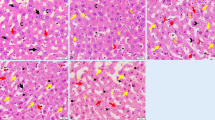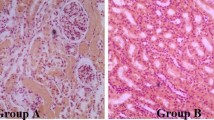Abstract
The goal of the present study was to investigate the biochemical and histological changes in dog’s kidney, liver, heart, and skeletal muscles within 72 h after death. Ten male mongrel dogs aged from 1 to 2 years old were subjected to this study. Dogs were euthanized by the rapid intravenous injection of a lethal dose of sodium thiopental, and then the liver, kidney, heart, and skeletal muscle samples were collected from the whole carcasses at different time intervals 4, 12, 24, 48, and 72 h postmortem. Samples were divided into two parts; one part was used for measuring tissue levels of lactate dehydrogenase (LDH), lactate, creatine phosphokinase (CPK), and aspartate aminotransferase (AST). The other part was subjected to histopathological examinations. On the biochemical level, LDH in the liver, kidney, and cardiac and skeletal muscles showed a significant increase at 4 h followed by significant decrease at 48 and 72 h in all the studied tissues. Lactate level showed variable degrees of increase and decrease in kidney and liver tissues while muscles showed increased lactate concentration during the first 48 h then decreased at 72 h. CPK in cardiac and skeletal muscles showed similar changes; it increased from 4 to 48 h then decreased at 72 h. AST level decreased in liver tissue at 4 until 72 h, while in muscular tissue it showed a delayed reduction in concentration which started at 12 and 24 h in the cardiac and skeletal muscles respectively. Similar changes of AST levels in both skeletal and cardiac muscles were observed; it increased at 4 h and then decreased at 24, 48, and 72 h. Histopathological changes in the kidneys were the earliest changes seen in tissue. The changes in the hepatic tissue were earlier than those of heart and skeletal muscle. We concluded that LDH enzyme showed regular changes in all examined tissues; the biochemical changes in cardiac and skeletal muscles were regular and can be useful in estimation of the time of death. The histopathological changes in the kidney, liver, and cardiac and skeletal muscles were very clear and can be used for estimating the postmortem intervals in dogs.





Similar content being viewed by others
References
Abo El-Noor MM, Elhosary NM, Khedr NF, El-Desouky KI (2016) Estimation of early postmortem interval through biochemical and pathological changes in rat heart and kidney. Am J Forensic Med Pathol 37:40–46
Bancroft TD, Stevens A (1996) Turner DR. theory and practice of histological technique, 4th edition. Churchill, Livingston, New York, London, San Francisco, Tokyo
Bhagavan NV (2002) Medical Biochemistry. Harcourt/Academic Press, San Diego
Brooks GA (2009) Cell-cell and intracellular lactate shuttles. J Physiol 587:5591–5600
Brooks JW (2016) Postmortem changes in animal carcasses and estimation of the postmortem interval. Vet Pathol 53:929–940
Buras KL. (2001) Are enzymes accurate indicators of postmortem interval? A biochemical analysis. Master thesis, the Department of Geography and Anthropology, Louisiana State University
Devlin TM (2002) Textbook of biochemistry with clinical correlations, 5th edn. Wiley-Liss, New York
Donaldson AE, Lamont IL (2013) Biochemistry changes that occur after death: potential markers for determining post-mortem interval. PLoS One 8(11):e82011. https://doi.org/10.1371/journal.pone.0082011
Enticknap JB (1960) Biochemical changes in cadaver sera in fatal acute heart attacks. J Forensic Med 7:136–146
Erlandsson M, Munro R (2007) Estimation of the post-mortem interval in beagle dogs. Sci Justice 47:150–154
Kimura M, Abe M (1994) Histology of postmortem changes in rat livers to ascertain hour of death. Int J Tissue React 16:139–150
Moss DW, Henderson AR (1999) Clinical enzymology. In: Burtis CA, Ashwood ER (eds) Tietz textbook of clinical chemistry, 3rd edn. W.B Saunders Company, Philadelphia, pp 617–721
Ozturk C, Sener MT, Sener E, Yilmaz I, Akcay F, Ucuncu Y, Suleyman H (2013) The investigation of damage in the muscle tissue with the oxidant/antioxidant balance and the extent of postmortem DNA damage in rats. Life Sci J 10:1631–1637
Perper J (2006) Time of death and changes after death. In: Spitz WU, Spitz DJ (eds) Medicolegal investigation of death: guidelines for the application of pathology to crime investigation, 4th edn, Springfield, Charles C. Thomas, pp 87–183
Scarpelli DG, Iannaccone PM (1995) Cell death, autolysis and necrosis. In: Kissane JM (ed) Anderson’s pathology, 9th edn. Mosby, St Louis, p 13
Schumann G, Klauke R (2003) New IFCC reference procedures for the determination of catalytic activity concentrations of five enzymes in serum: preliminary upper reference limits obtained in hospitalized subjects. Clin Chim Acta (32):769–779
Stein W (1998) Creatine kinase (total activity), creatine kinase isoenzymes and variants. In: Thomas L (ed) Clinical laboratory diagnostics. TH-Books Verlagsgesellschaft, Frankfurt, pp 71–80
Swift B (2010) Methods of time since death estimation within the early post-mortem interval. Journal of Homicide and Major Incident Investigation 6:97–112
Tavichakorntrakool R, Prasongwattana V, Sriboonlue P, Puapairoj A, Pongskul J, Khuntikeo N, Hanpanich W, Yenchitsomanus P, Wongkham C, Thongboonkerd V (2008) Serial analyses of postmortem changes in human skeletal muscle: a case study of alterations in proteome profile, histology, electrolyte contents, water composition, and enzyme activity. Proteomics Clin Appl 2:1255–1264
Thakur R, Goyal M, Dhiraj BA (2015) Study on estimation of time since death after histological examination of kidney. Int J Res Med Sci 3:1091–1096
Tietz NW (1995) Clinical guide to Laboratory Tests. W.B. Saunders Co., Philadelphia, p 384
Tomasz G, Stefan R (1993) Postmortem activity of lactate and malate dehydrogenase in human liver in relation to time after death. Int J Legal Med 106:25–29
Tomita Y, Nihira M, Ohno Y, Sato S (1999) Histological study of early postmortem changes in various organs: comparison of the paraffin embedding method and the epoxy resin embedding method. Nihon Hoigaku Zasshi 53:207–217
Tomita Y, Nihira M, Ohno Y, Sato S (2004) Ultrastructural changes during in situ early postmortem autolysis in kidney, pancreas, liver, heart and skeletal muscle of rats. Legal Med 6:25–31
Author information
Authors and Affiliations
Corresponding author
Ethics declarations
All procedures involving animals were done in accordance with the ethical standards of Assiut University. All rats were handled according to the standard guidelines for care and use of experimental animals. This article does not contain any studies with human participants performed by any of the authors.
Conflict of interest
The authors declare that they have no conflict of interest.
Rights and permissions
About this article
Cite this article
Yahia, D., El-Amir, Y.O. & Sadek, A.A.I. Early postmortem biochemical and histopathological changes in the kidney, liver, and muscles of dogs. Comp Clin Pathol 27, 1447–1455 (2018). https://doi.org/10.1007/s00580-018-2756-8
Received:
Accepted:
Published:
Issue Date:
DOI: https://doi.org/10.1007/s00580-018-2756-8




